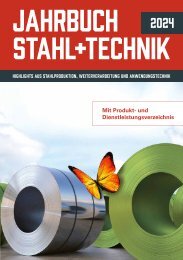STEEL + TECHNOLOGY 04/2019 EXTRACT
STEEL + TECHNOLOGY 04/2019 EXTRACT
STEEL + TECHNOLOGY 04/2019 EXTRACT
You also want an ePaper? Increase the reach of your titles
YUMPU automatically turns print PDFs into web optimized ePapers that Google loves.
<strong>STEEL</strong> PROCESSING | 77<br />
functions which used to be performed in<br />
separate steps on different machines.<br />
Thus non-productive times are significantly<br />
reduced.<br />
Besides a turning tool holder, the carriage-mounted<br />
tool unit can accommodate<br />
an ultrasonic testing probe, and drilling<br />
and milling heads. With these<br />
attachments the sleeve can firstly be finish-turned,<br />
followed by ultrasonic testing<br />
of the individual ring segments. This<br />
assures that whenever a portion of a<br />
sleeve does not meet the required specifications<br />
this will be identified at a very<br />
early stage and the corresponding material<br />
can be stopped from being further<br />
processed<br />
Boris Marcukaitis, sales engineer at<br />
Dango & Dienenthal, sees great benefits<br />
for his customers: “Sawing instead of turning<br />
alone provides tangible benefits in<br />
terms of material saving, quality and efficiency<br />
improvement, and cost reduction.<br />
On top of this, our new machine is able to<br />
perform further process steps without<br />
having to reclamp the workpiece. In this<br />
way, we enable our customers to manufacture<br />
rings on just one single machine,<br />
while in the past they usually needed three<br />
separate ones.”<br />
The functional principle<br />
The sleeve is firstly positioned on the<br />
turntable and clamped. At the top end –<br />
where the first ring is to be cut – the sleeve<br />
is fixed by means of height-adjustable<br />
clamping arms. Thanks to this arrangement,<br />
the height of the sawing kerf is held<br />
precisely constant throughout the cutting<br />
process.<br />
Simultaneously, the outside of the<br />
sleeve can be finish-turned and inspected<br />
over its entire height. Then the first ring is<br />
sawed off. It will not drop back onto the<br />
sleeve rim because it is securely held in<br />
place by the clamping arms. From there<br />
the ring can be lifted up and removed by a<br />
crane with ease. Afterwards, the clamping<br />
arms will be lowered to the position of the<br />
next ring to be cut.<br />
Milling, drilling and testing can be executed in the same clamping position (Picture:<br />
Dango & Dienenthal)<br />
The use of a turntable provides the<br />
advantage that the rings can be cut while in<br />
a horizontal position. This makes the loading<br />
of the machine and the removal of the cut<br />
rings much safer. Even while performing<br />
the last cut, the ring remains securely fixed.<br />
Technical data<br />
The clamping equipment can handle<br />
sleeves with diameters between 800 and<br />
more than 3,000 mm, and heights of up to<br />
1,000 mm. It can accommodate sleeve<br />
weights of up to 20,000 kg and cut ring<br />
weights of up to 3,000 kg. By cutting with<br />
a sawing blade, a radial cutting depth of up<br />
to 550 mm can be achieved.<br />
What is more, by sawing, rings with<br />
heights of only 15 to 20 mm can be produced.<br />
Such small ring heights cannot be<br />
produced by groove turning. By means of<br />
special clamping devices, such as “lost”<br />
jaws, it is even possible to cut rings of less<br />
than 4.5 mm height.<br />
• Dango & Dienenthal Maschinenbau<br />
GmbH, Siegen, Germany<br />
The prototype at Klaaßen Maschinenbau<br />
with that time exposed circular saw blade<br />
(Picture: Dango & Dienenthal)<br />
<strong>STEEL</strong> + <strong>TECHNOLOGY</strong> 1 (<strong>2019</strong>) No. 4


















